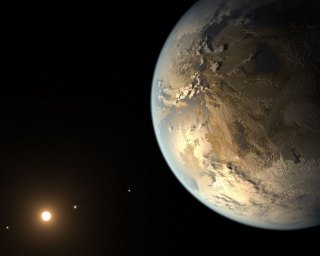A primer: Earth's 'cousin' orbits distant star

Artist's concept of Kepler 186f. Image:
NASA Ames/SETI Institute/JPL-Caltech
Dubbed Kepler 186f, the planet is 500 light years away, scientists said during a press conference April 17.
“We can now say that other, potentially habitable worlds similar in size to our Earth can exist and it is no longer in the realm of science fiction,” said Elisa Quintana, research scientist at the SETI (Search for Extraterrestrial Intelligence) Institute at NASA's Ames Research Center in Moffett Field, Calif.
The finding is a milestone in the work of scientists studying data from the Kepler Space Telescope. Launched in 2009, Kepler searched the Milky Way for planets in the habitable zone -- the range from a star in which the temperature of an orbiting planet might be suitable for water.
Here is a primer:
How did scientists “find” this planet?
They searched Kepler data for the dimming that occurs when a planet passes in front of its star. Using this method, they have doubled the number of known planets outside the solar system.The planet discovery described at the April 17 press conference was not the first breathless announcement from the Kepler team.
“To date, analysis of the data from just three years of those observations has revealed more than 3,800 exoplanet candidates,” said Douglas Hudgins, exoplanet exploration program scientist at NASA's Astrophysics Division in Washington. “More than 950 of those have subsequently been validated as actual planets and not false positive signals.”
Why is the size of this planet important?
Larger planets may not have a rocky Earth-like composition.“Thermal-evolution models predict that planets as small as Kepler 186f are unlikely to be dominated by these thick gas envelopes that you see on Neptune and Jupiter,” Quintana said. “We can deduce that planets about Earth’s size are likely to be rocky.”
Is the planet’s sun similar to ours?
Unlike Earth, Kepler 186f orbits a dwarf star, or as one scientist referred to it, a “little red dwarf.” Red dwarfs are the smallest and most abundant stars in the galaxy. In this case, the star is roughly half the size and mass of Earth’s sun, so the star is actually closer to Kepler 186f than Earth is to its sun. Kepler 186f orbits every 130 days and receives about one third of the solar heat that Earth gets from its sun.“This places the planet toward the cooler edge of the habitable zone,” Quintana said.
Earth and Kepler 186f orbit very different stars, remarked Thomas Barclay, research scientist at the Bay Area Environmental Research Institute at Ames. “Kepler 186f, then, is perhaps more of an Earth cousin than an Earth twin. It has similar characteristics to Earth but a different parent.”
Is the planet definitely habitable?
The fact that a planet is in a habitable zone doesn’t mean it is habitable.“We haven’t mentioned anything about the temperature of this planet, and that’s for a very good reason,” Barclay said during the press conference. “The temperature of a planet is strongly dependent on the atmosphere surrounding the planet.”
The planet’s interaction with its star is likely different than Earth’s interaction with the sun, explained Victoria Meadows, professor of astronomy at the University of Washington, Seattle, and principal investigator for the Virtual Planetary Laboratory, a team in the NASA Astrobiology Institute at Ames.
The habitable zone is closer to its star, so the star’s gravity and radiation could impact the planet’s habitability, she said.
Related:
NASA In Brief -- Scientists discover 750 new worlds; spacesuit helmet leak probed

